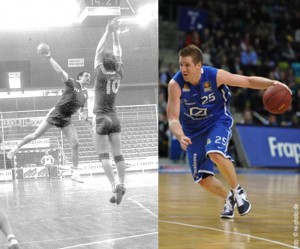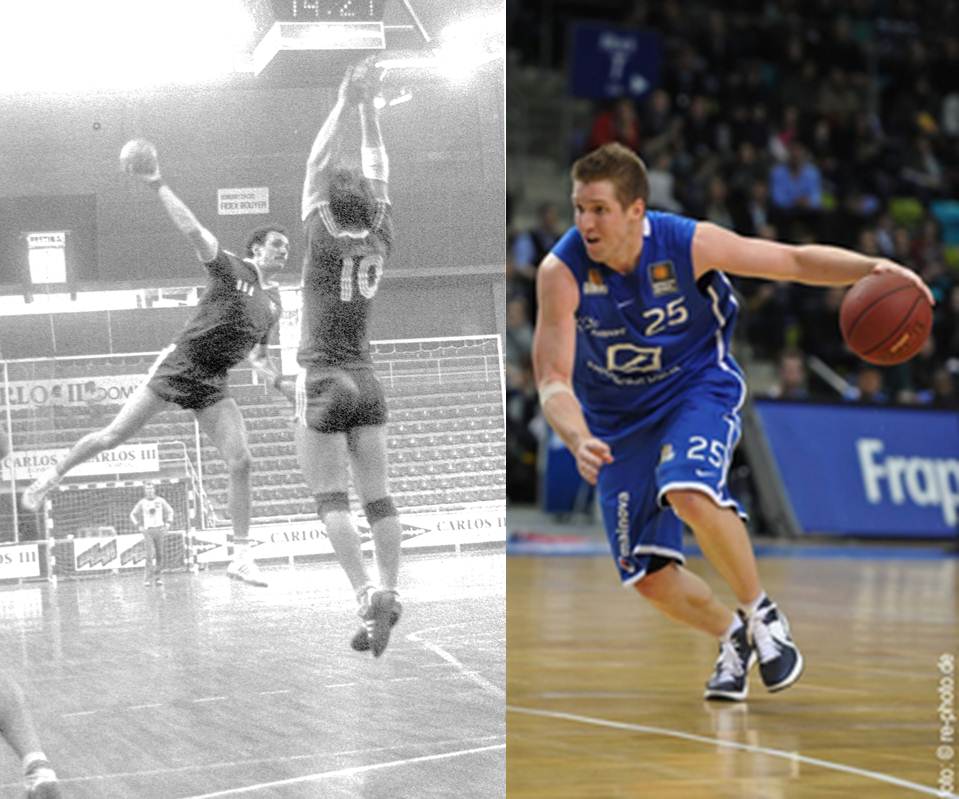
Post Academy sporting careers: Bob Djokovich, 78', with the USA National Team prior to the 84 Olympics and Jacob Burtschi, 07', with his current club, Germany's Fraport Skyliners
In the first part of this series I pointed out that if a downtrodden doormat like Air Force Basketball can execute a remarkable turnaround then it’s possible for USA Team Handball. In part 2, I highlight how Air Force basketball athletes have contributed to our national teams through the years and what this means for USA Team Handball as it seeks to recruit “blue chip” athletes.
Another Olympics is approaching and I’ll bet you dollars to donuts, that we’re bound to see a few more mainstream journalists discover Team Handball and write a commentary or two about how it wouldn’t take much for the USA to be good at it. Just get a few of our collegiate athletes to crossover to Team Handball after their career is over in their primary sport and it’s only a matter of time before this great sporting nation will be on the podium. And it’s not just journalists which often conclude that this is the path to follow. Here’s a quote from Interim USA Team Handball GM, Dave Gascon in a recent interview touting, A Change in Direction:
“We will no longer be the doormat of the Western Hemisphere. Simply put, there are thousands of blue-chip American athletes who would love to represent the United States in international competition. So while we are committed to a grass roots program to develop team handball with the youth our country, we are going to systematically go after those 400,000 NCAA athletes who go professional in something other than their scholarship sport after graduation.
Jeff and I independently came to the same conclusion that we would be foolish to not pursue our country’s best athletes who are in the last year of college or shortly after graduation. Look, these are some of the most competitive people on the planet and most have nowhere to go to continue to compete at a high level.”
It’s easy to see why a lot of folks come to this conclusion, particularly when they look at the raw physical talent on the rosters of the world’s top teams. Take for instance, Iceland, the silver medalist at the last Olympics. They have some decent athletic talent, but they aren’t by any means physically imposing. Heck, you could probably take any 1 out of 344 NCAA college basketball program in the U.S. and come up with a better crop of raw athletic talent; Doesn’t have to be Duke, Kentucky or Syracuse. Why, you could even take a mediocre (at best) program like Air Force and probably come up with the athletes you need to make a pretty good Team Handball squad….
And indeed, back in 1976 this hypothetical was exercised at a lower level when a group of cadets who played Team Handball intramurals at the Air Force Academy found out there was a club National Championship for the sport in the U.S. An intramural all-star team was thrown together, composed largely of athletes from the Men’s varsity hoops team and this unknown team showed up at the Club National Championships. The Air Force team, without the benefit of ever having seen how the game was supposed to be played quickly found out that the version of the game they had been playing in intramurals was only a rough facsimile of the real thing. Still, they were hands down the most athletic and physically conditioned team at the 3 day tournament. They adapted quickly and went on to take 2nd place, losing by two goals in the finals to a team that had several athletes on the USA’s 1976 Olympic Team.
So, if you can take a great group of athletes and overnight make them the 2nd best team in the country, I wonder what they might do at a higher level with a little bit more training. Well, the Air Force team didn’t become the National Team, but after Graduating from the Academy in 1978 two of those players, Bob Djokovich and Tom Schneeberger continued to play handball and were linchpins of the 1984 Olympic Team, arguably the best national team the USA Men’s program has ever had. If you put together a list of the all-time top American Team Handball players, those two are going to be very near the top of most everyone’s list. And, I would argue that their handball accomplishments all by themselves means that Air Force Basketball has made the most significant contribution of any one NCAA sport/school to the sport. (Note: Another AF Hoops player, 1979 Grad, Randy Gricius, also played on the National Team for a while and would have likely played in the 1980 boycotted Olympics)
But since 1979, while the Air Force Academy has sent several athletes to the National Team there hasn’t been a single player that was part of the Men’s Varsity Basketball team program. Why has that been the case for the last 33 years?
As an 87′ Grad who coached Team Handball at the Academy from 91-94 and also played service hoops with a couple of talented players I am in a fairly unique position to speak for the 80’s and 90’s decades. The most glaring obstacle for getting collegiate basketball players to take up handball was a decision sometime in the 1980’s to discourage intercollegiates from playing intramural sports. This shouldn’t come as a real surprise to anyone who follows NCAA sports nowadays. Teams aren’t allowed to practice out of season, but players are expected, and most want to, to continue working to improve their skills.
For all practical purposes, though, this eliminated the introduction of the sport and the possibility of those athletes really taking a liking to team handball while still in college. The only real chance to bring some of those athletes in was in the spring of their senior year after basketball season was over. At the same time, however, the Academy club was becoming more organized and this meant that the club players even if somewhat less gifted athletically still had a solid year or two of experience on a collegiate player. A basketball player or any other sport for that matter could join the club, but they would have a steep learning curve. Not to mention the fact that they would be integrating into a team that had already been practicing together for a couple of years.
But, what about bringing in some of those athletes after graduation? At that point their basketball options would be limited and even if they haven’t played handball you can’t graduate from the Academy without having seen the game played. By happenstance, I had the opportunity to play organized service basketball with two former AF players of significant pedigree, Mark Slimko (89) and Chris Loll (95). Both were about 6’5”, played forward and were team captains while at the Academy. As a former player on the U.S. National team, I certainly did my best to talk up the sport with them, but neither showed much interest. Either would have made a great Handball player and Loll, who was left-handed and had been a fairly accomplished high school baseball pitcher and football QB would have a lock.
Such a lack of interest, though, is not too surprising. While some might jump at the chance to be an Olympian, the reality is that it’s far more likely that accomplished athletes in their early to mid 20s will be starting to think a little bit more about the rest of their life. This was especially true since back then USA Team Handball couldn’t offer much more then modest dorm lodging, cafeteria food, a chance to travel and a modest stipend. Being an Olympian has its appeal, but it you’ve already played at a fairly high level in front of large crowds against some top notch competition, toiling away in obscurity for two weeks of Olympic glory just might not be worth it.
Flashing forward to the 21st century and it’s pretty much the same story, except USA Team Handball doesn’t even have the resources for lodging, cafeteria, and a stipend. Heck, without funding from the USA Team Handball Foundation national team athletes would even have had to pay for their own transportation to recent national team competitions.
To make matters even more challenging collegiate hoopsters now have far better opportunities to play professionally overseas. This, of course, was always an option, but the conditions and compensation were less enticing. Bob Djokovich, for instance turned down a modest offer to play for Red Star Belgrade. Professional basketball in Europe has come a long way with salaries now even getting the occasional NBA caliber player to play in Europe. From Sweden to Italy and from Spain to Turkey there are leagues looking for players and even players from less prominent colleges can make a comfortable living. I saw this first hand in France as the over 35 recreational team I played for sometimes had our practices start after the 2nd Div Pro team at our club finished. Each season there were a couple of Americans from lower tier Div 1 schools that had signed a contract and were living the dream: An apartment in Paris, perhaps 40K Euros/year and playing basketball for a living.
To continue the Air Force basketball angle I tracked down Jacob Burtschi, one of the key players who helped orchestrate the revival I highlighted in part 1. He’s now playing basketball for Frankurt’s Fraport Skyliners in the German 1st Division. It’s not the NBA, but it’s one of Europe’s top leagues and he’s definitely enjoying the opportunity to play professional basketball. Out of curiosity I asked him a few questions regarding Team Handball and the Academy. He certainly had seen the sport being played in intramurals, but had not played it. Now that he lives in Germany, he’s enjoyed watching the German Handball Bundesliga on TV. And he further assesses that raw talent wise, he might even be a better fit for handball. Having seen him play hoops, I’d have to concur with this assessment. He’s a great basketball player, but he’s also got the prototypical handball build. If he had played at the Academy 30 years ago chances are he would have taken up Team Handball. Given the current opportunities he has now, though, there’s little hope that we’ll ever see him or other blue chippers like him take up the sport.
While it may be unrealistic to expect that thousands of blue chip athletes will drop everything to pick up team handball it is still indeed foolish not to try. It will, however, not be easy and it will involve some targeted recruitment strategies and probably looking a rung or two below the true blue chip athlete. In part 3, I’ll take a closer look at some of these strategies by examining the handball careers of a couple of would be Air Force basketball players whose hoops careers never materialized.
Colorado Springs Gazette Telegraph (26 May 2011): Air Force grad Burtschi gets experience playing hoops overseas: http://www.gazette.com/articles/burtschi-118667-hood-story.html
Colorado Springs Gazette Telegraph (26 Feb 2009): Gazette picks all-time Air Force men’s basketball team: http://www.gazette.com/sports/career-48873-team-time.html
(Burtschi is in the starting lineup; Djokovich, Schneeberger and Gricius are reserves)
USA Team Handball (18 Jan 2012): A Change of Direction: http://usateamhandball.org/news/2012/01/18/a-change-of-direction/46210
